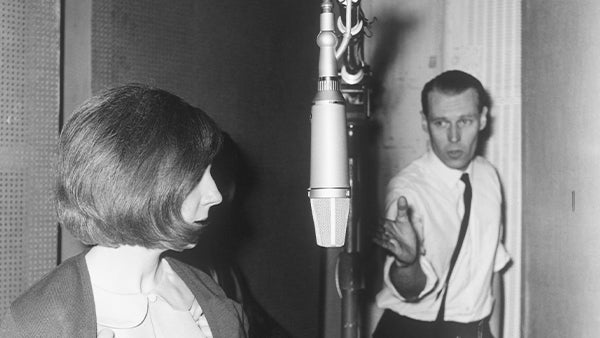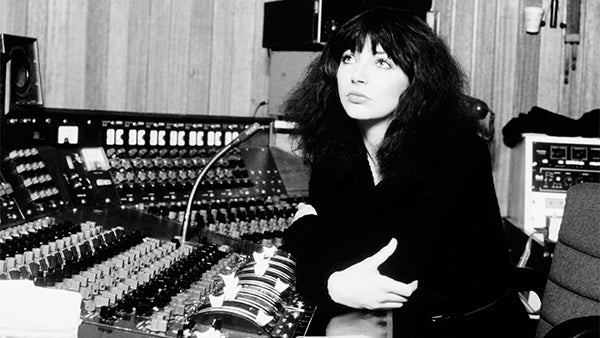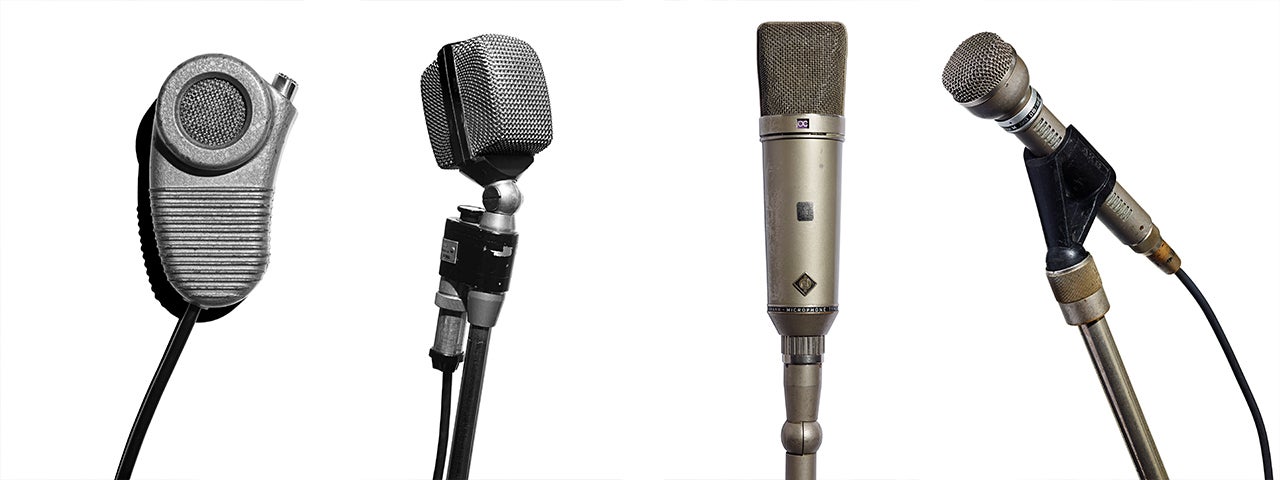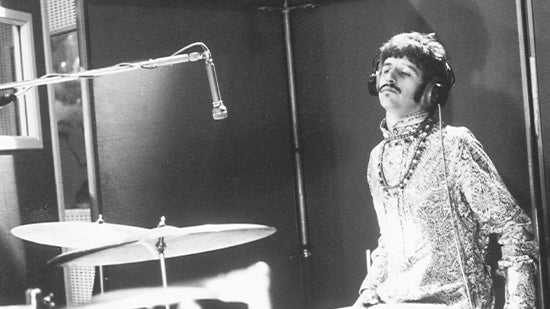Deep focus
Microphones are everyday objects at Abbey Road Studios, but not to photographer Rick Guest.
“These are, to all purposes, holy relics,” Rick Guest says, with a kind of hushed reverence. It’s about the only time throughout his hour-long audience with Cloud that the 57-year-old could be described as ‘hushed’. In fact, he’s so infectiously enthusiastic that you begin to understand how he talked his way into Abbey Road Studios in London to produce a gorgeous photography series focused on its microphones.
The result is The Art of Recording [Vol 1]: Out of Thin Air, a stunning set of large-scale images that depict, for instance, the microphone that The Beatles used for 1968’s ‘Yer Blues’, as well as the one that captured John Bonham’s seismic kick drum on Led Zeppelin’s ‘Whole Lotta Love’. Priced between £3,000 and £4,500 and currently available to purchase, the 18-strong collection is a testament to the power and history that inanimate objects can contain. Thanks to streaming services, music is arguably more ephemeral and less valued than ever, but Guest’s work is a celebration of the magic it brings to our lives.
For the Suffolk-based photographer, a Beatles fan who never had a chance to see the band in the flesh, it was a dream come true to create these artworks. It’s been a long road, mind. The seeds of the project were first sown back in 2018. Formerly an advertising photographer and director, Guest was working on a film for luxury car brand Maserati. When it came time to create a soundtrack for the film, it was suggested that they do so at Abbey Road, partly for publicity – this is, after all, the studio that gave The Beatles an album title – and partly because… well, who wouldn’t want an excuse to spend some time in its hallowed halls?
Magical Mystery Tour
The team found themselves stationed in Studio 2, which Abbey Road bills as its “most famous studio space” and has been home to all-time greats such as Oasis and Massive Attack. “You get very swept away with the juju of the building,” Guest recalls, “the sense of place and history.”
While he was soaking up the magic of the studio, he noticed a runner bobbing in with a microphone in “a beautiful black case”. The eagled-eyed photographer’s interest was piqued.
“I said, ‘Ooh, what’s that?’ He said, ‘Oh, you know, it’s a Neumann U 87.’ They know what every microphone has been used on.” At this point, somewhat astonished, Guest asked: “’What, so you can point at a microphone and go, “That was in the room for Paul McCartney singing ‘All You Need Is Love’ or Dave Gilmour thumping away on his black Stratocaster?” Somewhat nonchalantly, the runner replied: ‘Yeah, pretty much!’”
This moment sparked a kind of creative epiphany in the photographer. “You’re walking down the corridors and there’s stuff everywhere. You’ll say to the person you’re with: ‘Oh, what’s this?’ And they’ll say: ‘It’s in the way!’ And you’ll say: ‘No, but what is it?’ ‘Oh, that’s a BTR-3 – that’s the first-ever stereo machine that the Beatles used.’” He nods in astonishment. “There’s no archive and it’s being used, so it’s just piled up all over the shop. You know, I have the joy of being an outsider and it often takes someone from the outside to go, ‘Hey! Look what you guys have got! You guys have got something amazing!’”
The thought kept coming back to him “that these items, these objects, these artefacts were present at these incredible events, these very historic and – I know we use this word a lot – iconic tracks.”
It was about a year before the penny dropped that there could be a great photography project in all this. Unfortunately, he had no real contacts at Abbey Road or much of an idea as to how he might approach them. As it happened, a friend of Guest’s collects film and TV props. If you watch The Crown and see “a microphone and a Royal family member is speaking into it or anything technical like that, they belong to him”.
After the pandemic caused him to reassess his priorities and pursue creative passion projects above all else, Guest procured half a dozen vintage mics from his friend to produce a mock-up of the photography series. He then presented this to Mark Robertson, Head of Brand and Communications at Abbey Road. Together, sitting in the canteen of this British institution and looking out onto the cloistered courtyard outside, they hatched a plan. “Here’s something I made earlier,” Guest joked as he presented Robertson with his Blue Peter-style creation. “I think it’s a thing,” said Robertson. “Yeah,” replied Guest. “I think it’s a thing too…”


Real love
From here, there was one more gatekeeper that the photographer needed to win over before he could immortalise the microphones which themselves have crystallised so much popular culture: Lester Smith, ‘the keeper of the keys’. The custodian of Abbey Road’s microphone collection, Smith has worked at the studio since 1970 and he’s as much a part of the place as the branded mugs that musicians sip from as they make history. Smith’s primary job is to repair the mics and keep them in good working order – as he explained, they’re made from increasingly elderly technology and “you don’t get spare parts”.
Guest’s outsider status paid dividends when Smith offered to provide a brand new ‘spit shield’ – a metallic covering that protects the delicate microphone pick-ups – because he felt it would be more aesthetically pleasing than a vintage one which was covered in brown marks. When Guest pressed Smith on the source of those brown marks, the latter explained that it was rust and experienced an epiphany of his own when he realised this was caused by ‘Beatle spit’. It turned out that John Lennon was renowned for singing so hard into the mics that he damaged the technology behind the ‘spit shield’. Smith and the photographer had been scheduled for a 15-minute chat about the project, but were still in raptures about microphones hours later.
You can feel this level of passion and – dare we say it – musical geekery in The Art of Recording. Blown up at scale, the beautifully photographed microphones look battle-worn and lived in; it’s their imperfections that make them so compelling. A snap entitled ‘‘Interstellar Overdrive’ Pink Floyd – STC (Coles) 4038 [1967]’, for example, portrays a rust-encrusted dropdown mic that was blown out when Pink Floyd’s Roger Waters blasted his cavernous bass sound through it.
Guest is currently in the early stages of a second instalment in The Art of Recording, for which he’ll group together different instruments that were used to record a particular – yes – iconic track. For one piece, he intends to combine the microphone, bass guitar and handwritten lyrics that came together in the recording of The Beatles’ ‘Sgt. Pepper’s Lonely Hearts Club Band’. The photographer recently tracked down the bass drum from the indelible cover of the album from which the song takes its name: “A collector has that – it took me three years to find it.”
And then Guest is off again, riffing on the scars borne by Paul McCartney’s bass guitar: “[There are] scratches under the strings – it’s just incredible!”. His excitement is hugely cheering and proof that, to make your dream become a reality, all you need is love.
Image Credit: UMG Archive

 Microphones are everyday objects at Abbey Road Studios, but not to photographer Rick Guest.
Microphones are everyday objects at Abbey Road Studios, but not to photographer Rick Guest.

